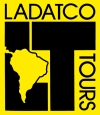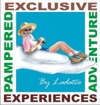

Destinations
Experiences
 |
L A
D A T C O T O U R
S |
 |
||||||||
| HOME | South America | Falkland Islands | Antarctica | Unique Destinations |
Unique Experiences |
Newsstand | ||||
|
Estancia Cristina Parque Nacional Los
Glaciares |
|
 |
 |
 |
 |
ABOUT ESTANCIA CRISTINA - in their own words:
HISTORY:
Estancia Cristina was founded in 1914 by Joseph Percival Masters, an Englishman who came to Patagonia with his wife in 1900. Having heard marvels about the Patagonian lands of Southern Argentina and being in search of a promising future, he decided to embark with his wife towards Buenos Aires, to later travel to Río Gallegos. They soon found employment and had two kids: Percival Herbert Masters in 1902 and Elinor Cristina Masters in 1904. The Masters had for a long time heard about the territories situated near a great Lake called Argentino, where there were fine lands for cattle raising waiting for adventurous pioneers. After having saved some money, they started their journey from Río Gallegos towards the west.As time went by, Mr. Master was able to acquire a small rescue boat from a shipreck, with which he started to transport all his belongings -including cattle-, towards a sheltered place in the southern bank of the North Channel Square Bay (Bahía Escuadra). As the rough lake and winds prevented him from sailing with his tiny ship, he recovered and rebuilt an old steam boat which he baptized Cesar. It was in this way that he restarted to transport his possessions towards the Brazo Norte (north channel) of the Lago Argentino, known currently as Brazo Cristina.
Mr Masters named his home Estancia Cristina in honour to his little daughter. They lived in tents set near the lake for the first year. Needless to say, the first years were times of hard work, effort and restraint. The estancia grew and had up to 22,000 hectares of land surrounded by glaciers, snow peaks and lakes of great natural beauty. Cattle then consisted of 27,000 sheeps, 30 cows and some 50 horses. When Mr. and Mrs. Masters died, the estancia went into Herbert´s hands, who was then married to Janet Mc Donald. Herbert died in 1984, leaving Janet to manage the property alone. Janet died in 1997. We nowadays keep well alive the history of this family who -with the effort and endurance common to every old pioneers- left an everlasting mark in this unique region.
LOCATION:
Located in Parque Nacional “Los Glaciares”, in the province of Santa Cruz.
Surrounded by forests, lakes and mountains.
At the entrance of the Patagonian Ice fields.
In the Canal Cristina of the Lago Argentino.
At the base of the majestic Cerro Norte (2,730 meters)
Settled in one of the most fascinating, unknown and legendary valleys of Patagonia.GETTING THERE: Click here for map
The Estancia can only be reached by lake transportation. The trip starts in Puerto Punta Bandera, sailing the northern arm of the Argentino Lake up to the Upsala Channel (limit defined). It takes 3 hours to get to Estancia and only 2 hours when it returns to el Calafate the day you leave.There are 2 schedule for Lodge programs, one of which allows guest to go directly to Estancia from the airport (early in the morning) or take a flight the same day of departure (late afternoon flights).
ESTANCIA CRISTINA HAS: Day Visit - Overnight & Multi-night stays
|
OPEN: October 15 through April 15 |
||
|
THE MAIN LODGE |
FIVE BUNGALOWS |
RESTAURANT |
|
The main area of the Estancia, commonly referred to as the “Octogon” because of its peculiar shape, houses the reception area which offers round-the-clock guest services and assistance. In line with the Estancia’s aim to have its guests disconnect from the outside world, this is the only area that has wifi connectivity. |
 Each guestroom is 31.5 square meters (approximately 104 square feet) and has a private bathroom, central heating and amenities. The large bow windows open onto breathtaking views that help guests disconnect from the outside world. In line with this off-the-grid experience, guestrooms do not have phones, TV or wifi. |
The Estancia offers specially selected dishes for a perfect stay, including regional flavors and mouthwatering meat barbeques or “asados”. Stays at the Estancia include all meals (breakfast, lunch, afternoon tea, dinner, snacks) and non-alcoholic beverages. From the moment of arrival and until departure, guests have these services available in the Octogon |
WEATHER:
Within the National Park the weather is mostly marked by great variations in temperature and constant winds. According to the Koeppen classification, the weather in the National Park is described as template, rainy, with no rainy season strongly defined but rather lesser rainfall in summer months.
The rainfall increases from the west, registering about 500 millimeters form the oriental limit of the Park to approximately 900 millimeters in the mountains.Rain is distributed throughout the year, with most rain falling towards the end of autumn (April – May). Snow is present throughout the whole winter but not enough to produce great accumulations.
Winds prevail from the west and southwest, summer being the windiest season.The weather is changeable, with substantial temperature ranges between day and night.
| Summer (December to March)
Min.07 C Max.24 C |
Spring (September to December) Min.05 C Max.15 C |
Fall (March to May)
Min.05 C Max.12 C |
Winter (May to September)
Min. -05 C Max.05 C |
FREQUENTLY ASKED QUESTIONS:
What type of clothes should I take?
- Gloves
- Scarf
- Waterproof jacket
- Rubber sole shoes (for trekking) or sneakers
- Sunglasses
- Sun-block lotion (facial and lips)
- Advice: in Patagonia, it is advisable to wear clothes in layers so that you can take them off according to the temperature.
Is the Estancia open all year round?
No. The Estancia Cristina is open to guests from October 15-April 15.
How long does the sunlight last?
In summer, there is sunlight from 5 in the morning to 10 in the evening. During winter, the sun rises at 8 in the morning and sets at 6 in the evening.
How long does it take to get to Punta Bandera port?is the trip from Los Notros to the port?
From downtown El Calafate: 30 mintes; from Los Notros 45 minutes; from Eolo 30 minutes.